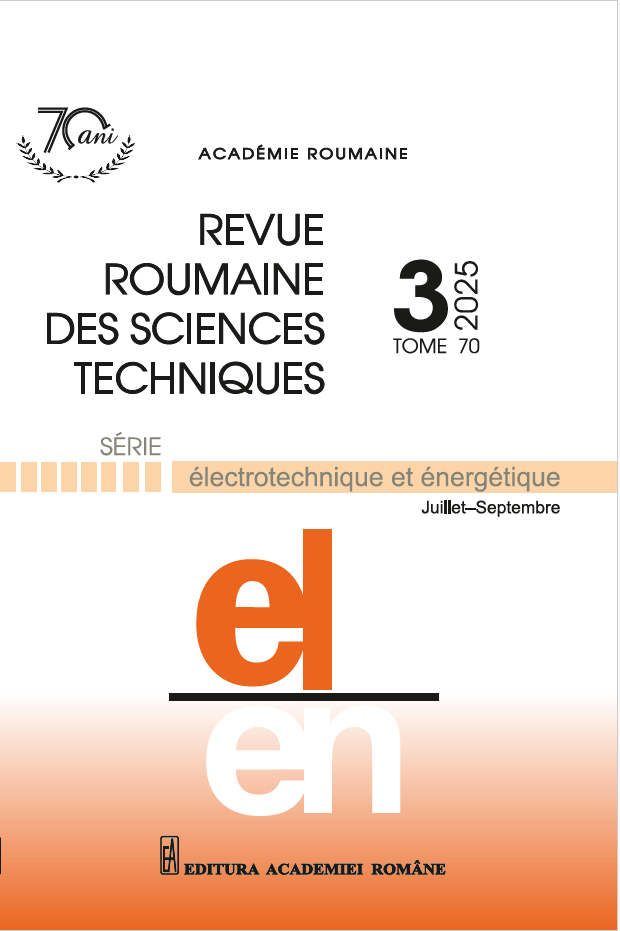TWO-STAGE INCLINED-PLANE ELECTROSTATIC SEPARATOR FOR MILLIMETER-SIZED PARTICLES
DOI:
https://doi.org/10.59277/RRST-EE.2025.3.3Keywords:
Electrostatic separation, Tribo-electricity, Plastic particles, Recycling, Experimental design methodologyAbstract
This paper aims to study and optimize a new configuration of an inclined-plane-type electrostatic separator. The device consists of two inclined planes arranged in a cascade. The design is aimed at efficiently separating millimeter-sized particles, specifically polycarbonate (PC) and polyamide (PA). Preliminary experiments were conducted to investigate the effects of various operating parameters on separation efficiency, including tribo-electric charging time, fluidizing air speed, and the angle between the high-voltage electrodes. The design of experiments (DOE) methodology was employed to model the outcome of the separation process, focusing on two control variables: the length of the electrodes generating the electric field and the applied voltage level. The results revealed the existence of optimal values, resulting in a product recovery rate of 97 %, with high purity levels (98 % for PC and 96% for PA).
References
(1) M. Burgess, H. Holmes, M. Sharmina, M. P. Shaver, The future of UK plastics recycling: one bin to rule them all, Resources, Conservation and Recycling, 164, pp. 105191 (2021).
(2) N. Kadri, W. Krika, A. N. Ayad, T. Rouibah, F. B. Ahmet, E. Kadir, I. R. Bara, S. S. M. Ghoneim, Recovery of non–ferrous particles from recycling neon lamps by magnetic induction separator, Rev. Roum. Sci. Techn. – Électrotechn. Et Énerg., 69, 3, pp. 283–286 (2024).
(3) L. M. Dumitran, L.V. Badicu, M.C. Plopeanu, L. Dascalescu, Efficiency of dual wire–cylinder electrodes used in electrostatic separators, Rev. Roum. Sci. Techn. – Électrotechn. Et Énerg., 55, 2, pp. 171–180 (2010).
(4) M. Kahaleras, M. Remadnia, M. Kachi, A. Nadjem, Semolina extraction from wheat bran using an electro–separation process, Journal of Food Processing and Preservation, 45, 4, e15352 (2021).
(5) S. Tabtabaei, D. Konakbayeva, A.R. Rajabzadeh, R.L. Legge, Functional properties of navy bean (Phaseolus vulgaris) protein concentrates obtained by pneumatic tribo–electrostatic separation, Food Chemistry, 283, pp. 101–110 (2019).
(6) T. Phengsaart, P. Julapong, C. Manositchaikul, P. Srichonphaisarn, M. Rawangphai, O. Juntarasakul, K. Aikawa, S. Jeon, I. Park, C.B. Tabelin, M. Ito, Recent Studies and Technologies in the Separation of Polyvinyl Chloride for Resources Recycling: A Systematic Review, Sustainability, 15, 18, pp. 13842 (2023).
(7) A. Iuga, A. Samuila, R. Morar, M. Bilici, L. Dascalescu, Tribocharging techniques for the electrostatic separation of granular plastics from waste electric and electronic equipment, Particulate Science and Technology, 34, 1, pp. 45–54 (2016).
(8) J. Li, Z. Xu, Compound tribo–electrostatic separation for recycling mixed plastic waste, Journal of Hazardous Materials, 367, pp. 43–49 (2019).
(9) S. Mouhoub, M. Kachi, N. Zouzou, Influence of the initial charge on the triboelectrification of a millimeter-sized set of particles in an inclined tube, Powder Technology, 428, pp. 118862 (2023).
(10) Y. Shen, D. Tao, L. Zhang, H. Shao, X. Bai, X. Yu, An experimental study of triboelectrostatic particle charging behavior and its associated fundamentals, Powder Technology, 429, pp. 118880 (2023).
(11) S. Matsusaka, H. Maruyama, T. Matsuyama, M. Ghadiri, Triboelectric charging of powders: A review, Chemical Engineering Science, 65, 22, pp. 5781–5807 (2010).
(12) M. Maammar, T. Zeghloul, W. Aksa, S. Touhami, I. Achouri, L. Dascalescu, Factors that influence the trajectories of charged insulating particles in roll–type electrostatic separators, Journal of Electrostatics, 115, pp. 103672 (2022).
(13) P. M. Ireland, Modelling dense particle streams during free–fall electrostatic separation, Powder Technology, 434, pp. 119290 (2024).
(14) A. Nadjem, M. Kachi, K. Rouagdia, M. Remadnia, Experimental Study of an Inclined–Plane Electrostatic Separator, In: Proceedings of the Third International Symposium on Materials and Sustainable Development, Cham: Springer International Publishing, pp. 439–450 (2018).
(15) I. E. Achouri, G. Richard, T. Zeghloul, K. Medles, L. Dascalescu, New Vibrating–Table–Type Tribo–Electrostatic Separator for Selective Sorting of Granular Plastic Wastes, IEEE Transactions on Industry Applications, 60, 2, pp. 3537–3542 (2024).
(16) S. M. Al-Salem, P. Lettieri, J. Baeyens, Recycling and recovery routes of plastic solid waste (PSW): A review, Waste Management, 29, 10, pp. 2625–2643 (2009).
(17) K. Rouagdia, L. Dascalescu, Robust optimum operating conditions for AC corona neutralization of insulating materials, Rev. Roum. Sci. Techn. – Électrotechn. Et Énerg., 65, 1–2, pp. 5–10 (2020).
(18) S. V. Silva, J.S. Cardoso, V. Silva, J.S. Cardoso, Response Surface Methods – Theory, Applications and Optimization Techniques, IntechOpen, London, UK. (2024).
(19) ***User Guide and Tutorial to MODDE: Version 8.0, Umetrics, Umea, Sweden (2006).
Downloads
Published
Issue
Section
License
Copyright (c) 2025 REVUE ROUMAINE DES SCIENCES TECHNIQUES — SÉRIE ÉLECTROTECHNIQUE ET ÉNERGÉTIQUE

This work is licensed under a Creative Commons Attribution-NonCommercial-NoDerivatives 4.0 International License.


